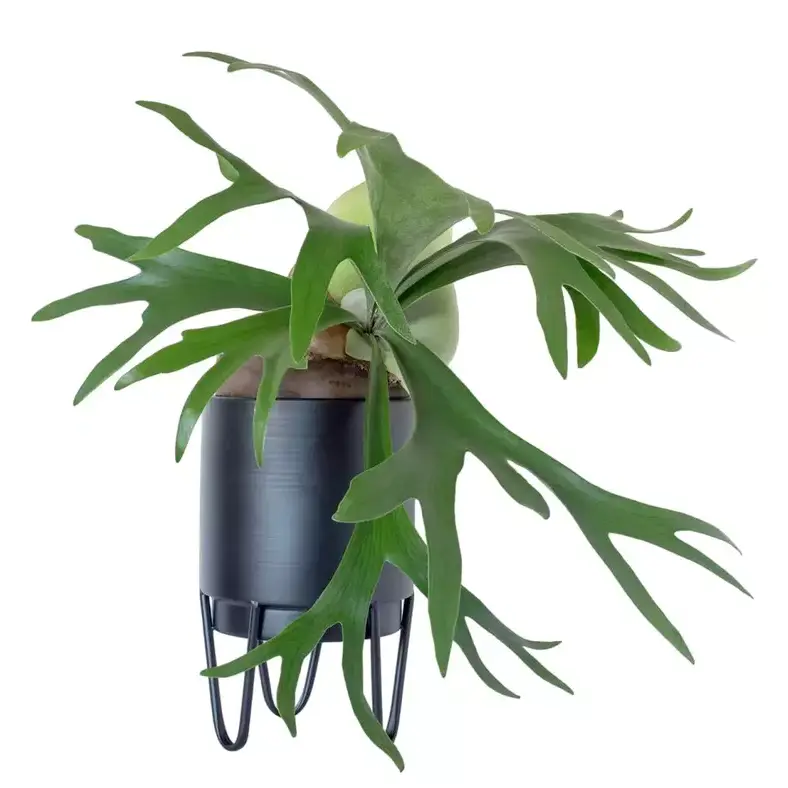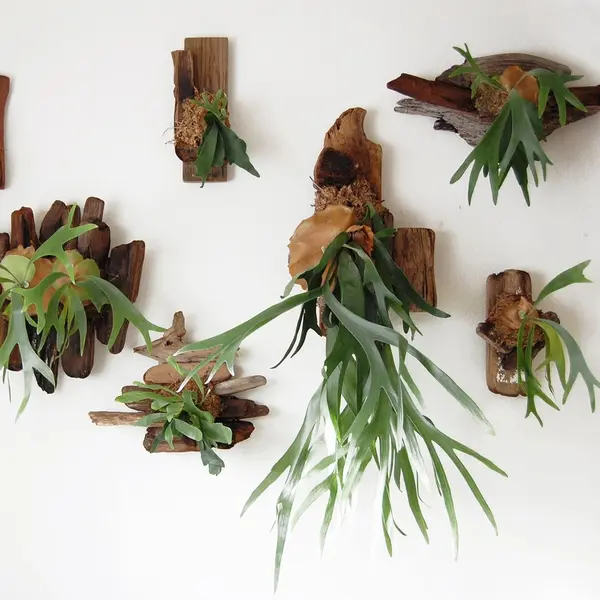Staghorn Fern – Rare
Original price was: ₹1,980.00.₹649.00Current price is: ₹649.00.
2 in stock
Selling Size: Single Plant | 4″ Pot Included
Staghorn ferns (genus Platycerium) are unique and striking epiphytic plants, meaning they naturally grow on other plants (like trees) or rocks rather than in soil. They are known for their distinctive fronds that resemble the antlers of a stag. While they look exotic, they are relatively easy to care for if you understand their specific needs.

Here’s a comprehensive guide to staghorn fern care:
1. Light:
- Bright, indirect light is ideal. Mimic their natural habitat under a tree canopy.
- Avoid direct sunlight, especially harsh afternoon sun, as it can scorch their fronds.
- East or north-facing windows are usually best. If you have a south or west-facing window, use a sheer curtain to diffuse the light.
- Insufficient light can lead to weak, leggy growth.
2. Watering:
- Consistency is key, but avoid overwatering. Staghorn ferns absorb water through both their fronds and roots.
- Soaking method is often preferred:
- Submerge the entire mounted plant (or the root ball if potted) face down in a sink or basin of room-temperature water for 5-10 minutes, or until the moss/medium is fully saturated.
- Allow the plant to drip dry completely before re-hanging.
- Alternatively, you can run water over the root ball until it’s saturated.
- Misting: Staghorn ferns appreciate high humidity, so regular misting of the entire plant (especially the underside of the antler fronds and shield fronds) is beneficial, particularly in dry environments.
- Frequency:
- Warm, dry months (growing season): Water once a week.
- Cooler months (dormancy): Reduce watering to once every one to two weeks, or even monthly.
- Humidity: If your fern is in a very humid environment (like a bathroom), you may need to water less frequently.
- Signs of watering issues:
- Browning/blackening at the base of antler fronds: Overwatering. Reduce frequency.
- Browning tips or wilting fronds: Underwatering. Increase frequency.
- Black spots on shield fronds: Overwatering and/or poor air circulation.
3. Humidity:
- Staghorn ferns are native to tropical and subtropical regions and thrive in high humidity.
- In dry indoor environments, supplement humidity by:
- Misting regularly.
- Using a humidifier nearby.
- Placing the plant on a pebble tray with water (ensure the pot isn’t sitting directly in the water).
4. Temperature:
- They prefer warm temperatures, generally between 16-25°C (60-77°F).
- Avoid sudden drops in temperature, especially below 12°C (50°F).
- Protect them from drafts from windows, air conditioners, or heating vents.
- They can be placed outdoors during warm seasons, but bring them inside when temperatures consistently drop below 10-15°C (50-60°F).
5. Mounting and Potting:
- Staghorn ferns are often grown mounted on a board or piece of wood, mimicking their natural growth habit. This also allows for good air circulation around their roots.
- Mounting materials: Wooden boards, cork bark, driftwood, or wire baskets lined with sphagnum moss or coconut coir are common choices.
- Mounting process:
- Gently remove excess soil from the root ball.
- Soak sphagnum moss thoroughly and squeeze out excess water.
- Place a layer of moss on your chosen mounting surface.
- Position the fern’s root ball on the moss.
- Secure the fern and moss tightly to the board using fishing line, nylon string, or thin wire. Loop the line over the moss and around the board, tying it securely.
- Ensure the “shield fronds” (the flat, rounded basal fronds) are protected, as they help anchor the plant and collect nutrients.
- While often mounted, they can also be grown in pots with a very well-draining, airy medium like an equal mixture of peat moss, sphagnum moss, and bark (similar to orchid mix).

6. Feeding (Fertilizing):
- Staghorn ferns are not heavy feeders.
- During the active growing season (spring and summer):
- Feed monthly with a diluted, balanced liquid fertilizer (e.g., 1:1:1 ratio).
- Some growers also place a piece of banana peel under the shield frond for potassium (though this can attract fruit flies indoors).
- During dormancy (fall and winter): Reduce or stop fertilizing.
7. Fronds:
- Staghorn ferns have two types of fronds:
- Basal (shield) fronds: These are the flat, rounded, overlapping fronds at the base. They initially appear green but naturally turn brown and papery with age. Do not remove these, as they protect the roots and collect detritus for nutrients.
- Foliar (antler) fronds: These are the more upright, branched, antler-like fronds. Spores are produced on the underside of these fronds (they will look like brownish masses or fuzz) – do not remove them.
- Pruning: Only remove dead or severely damaged antler fronds using clean, sharp scissors.

8. Pests and Diseases:
- Generally resistant, but keep an eye out for common houseplant pests like scale insects and mealybugs. Treat promptly with insecticidal soap or neem oil if found.
- Overwatering is the most common cause of problems, leading to root rot or fungal issues. Ensure good air circulation.
By providing consistent bright, indirect light, appropriate watering, high humidity, and the right mounting/potting medium, your staghorn fern can thrive and become a stunning focal point in your home.
Only logged in customers who have purchased this product may leave a review.












 If you need any assistance, I'm always here. Have you found what you were looking for?
If you need any assistance, I'm always here. Have you found what you were looking for?
Reviews
There are no reviews yet.